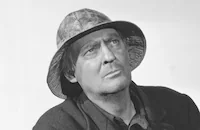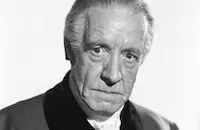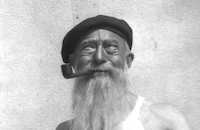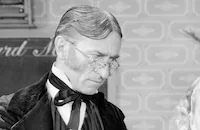Treasure Island

Brief Synopsis
Cast & Crew
Victor Fleming
Wallace Beery
Jackie Cooper
Lionel Barrymore
Otto Kruger
Lewis Stone
Film Details
Technical Specs

Synopsis
Young Jim Hawkins and his mother run the Admiral Benbow Inn near Bristol, England. During a birthday celebration, the mysterious Billy Bones arrives and drunkenly talks about treasure. Soon after, Bones is visited by Black Dog then Pew, and drops dead, leaving a chest, which he bragged contained gold and jewels. Instead of money, Jim finds a map that his friend Dr. Livesey realizes will lead them to the famous Flint treasure. Squire Trelawney raises money for a voyage to the treasure island and they set sail on Captain Alexander Smollett's ship. Also on board is the one-legged Long John Silver and his cronies. Even though Bones had warned Jim about a sailor with one leg, they become friends. During the voyage, several fatal "accidents" happen to sailors who disapprove of Silver and his cohorts. Then, the night before landing on the island, Jim overhears Silver plotting to take the treasure and kill Smollett's men. Jim goes ashore with the men, and encounters an old hermit named Ben Gunn, who tells him that he has found Flint's treasure. Meanwhile, Smollett and his men flee to the island's stockade for safety. Silver's men then attack the stockade when Smollett refuses to give them the treasure map. While the situation looks hopeless, Jim secretly goes back to the ship at night, sails it to a safe location and shoots one of the pirates in self-defense. When he returns to the stockade, Silver's men are there and Silver tells them that a treaty has been signed. The pirates want to kill Jim, but Silver protects him. Dr. Livesey comes for Jim, but the boy refuses to break his word to Silver not to run away. The next day the pirates search for the treasure hold and when they find it, it is empty. When some of the pirates mutiny against Silver, Livesey and Gunn join him in the fight. Smollett then sails home with the treasure, which Gunn had hidden in his cave, and with Silver as his prisoner. Unable to stand by and let his friend be hanged, Jim frees Silver. As he sails away, Silver promises to be good.

Director

Victor Fleming
Cast

Wallace Beery

Jackie Cooper

Lionel Barrymore

Otto Kruger

Lewis Stone

Nigel Bruce

Charles "chic" Sale

William V. Mong
Charles Mcnaughton

Dorothy Peterson

Douglas Dumbrille

Edmund Breese

Olin Howland

Charles Irwin
Edward Pawley
Richard Powell

James Burke
John Anderson
Charles Bennett
Wes Clark

Harry Cording
Yorke Sherwood

J. M. Kerrigan
Matt Gillman
Bob Anderson
A. B. Lane

John Kerr

Tom Wilson
John Northpole
Edwin J. Brady
Frank Hagney
Bill Dooley
Bob Stevenson
Red Burger
Jack Hill
King Mojave
Tom Mahoney
Sidney D'albrook
Frank Dunn
Robert A'dair
Cora Sue Collins
Harold Nelson
Bernice Beatty
Edith Kingdon
Vernon Downing
Bobby Bolder
Wilson Binge
Sharlee Simpson
Kay Deslys
Jane Tallent
Ethel Ransome
Jill Dennett
Harold Entwistle
Crew
Bob Davis
Clyde Devinna
Dwight Franklin
Cedric Gibbons
Horace Hough
Ray June
John Howard Lawson
John Lee Mahin
Leonard Praskins
Merrill Pye
Harold Rosson
Blanche Sewell
Douglas Shearer
Robert Shirley
Herbert Stothart
Hunt Stromberg
Edwin B. Willis

Photo Collections
Videos
Movie Clip



Film Details
Technical Specs

Articles
Treasure Island (1934)
An adrenaline-pumping tale for boys that was popular long before the appearance of heroic adventurers like Indiana Jones, Treasure Island was altered slightly to please MGM chief Louis B. Mayer. Having never read the book or the shooting script, Mayer was distressed at the lack of a happy ending. To make matters worse, there was no scene of little Jackie Cooper crying - his signature in those days. Insisting that audiences wanted both a happy ending, and waterworks from Cooper, Mayer demanded re-shoots resulting in the film as seen today. But the re-shoots did not come easy. Beery, who was no walk in the park under the best circumstances, resented being summoned back to play a supporting role in Cooper's scene, so he did his best to be difficult. He would blow lines, and he would stall by hiding out in his dressing room, or excusing himself to the restroom immediately after he appeared on set. When all was said and done, Beery managed to stretch a two and a half page scene, scheduled for just one day of shooting, into nearly a week.
All in all, the film delivers on its promise of intrigue and imagination, fueled by John Lee Mahin's screenplay, and Victor Fleming's direction. Variety noted when the film was released that "Fleming's direction has some exceptionally fine photographic effects - effects that can't help but impress." This was no doubt excellent training for Fleming before going on to direct impressive spectacles like The Wizard Of Oz (1939), and Gone With The Wind (1939). And just like those later epics, Treasure Island is an awful lot of fun and appeals to the adventurer in all of us.
Director: Victor Fleming
Producer: Hunt Stromberg
Screenplay: John Lee Mahin, John Howard Lawson (uncredited), Leonard Praskins (uncredited), based on the novel by Robert Louis Stevenson
Cinematography: Clyde DeVinna, Ray June, Harold Rosson
Editor: Blanche Sewell
Art Direction: Cedric Gibbons, Merril Pye (associate)
Music: Herbert Stothart
Cast: Wallace Beery (Long John Silver), Jackie Cooper (Jim Hawkins), Lionel Barrymore (Billy Bones), Otto Kruger (Dr. Livesey), Lewis Stone (Capt. Smollett), Nigel Bruce (Squire Trelawney)
BW-104m. Close captioning. Descriptive Video.
by Bill Goodman

Treasure Island (1934)
Motion Picture Masterpieces - MOTION PICTURE MASTERPIECES - 5 MGM Favorites on DVD Including "David Copperfield" & "Pride and Prejudice"
Hollywood's first movie version of Pride and Prejudice, directed by Robert Z. Leonard and released in 1940, has never been topped. One reason is superb production work by art director Cedric Gibbons, costume designers Adrian and Gile Steele, and cinematographer Karl Freund, who forgoes his German Expressionist roots to capture exquisite images of England in the early 19th century. The film's other big triumph is its cast, topped by Greer Garson as lively, lovely Elizabeth Bennet and Laurence Olivier as her prideful suitor Mr. Darcy, an ideal role that elicited one of his most restrained and refined performances. The movie adds gimmicky episodes for visual excitement-a carriage race, an archery contest-and sugar-coats the ending. But it's terrific entertainment anyway.
Marie Antoinette, directed by W.S. Van Dyke in 1938, turns the MGM design team loose on the sumptuous Versailles Palace in 18th-century France, where our heroine copes with a hapless husband, falls for a Swedish aristocrat, outgrows youthful irresponsibility to become a compassionate queen, and faces the guillotine after the French Revolution erupts. Norma Shearer is excellent in the title role. Tyrone Power plays the underwritten Count Axel with elegance and charm. And many scenes get stolen by Robert Morley as the Dauphin, a tragicomic character who's heading for the throne but can't figure out how to consummate his marriage. This opulent production is more conventional than the 2006 remake by Sofia Coppola, but just as absorbing. MGM had a flair for the French Revolution, giving it even stronger treatment in Jack Conway's marvelous 1935 version of Charles Dickens's novel A Tale of Two Cities, starring Ronald Colman as the self-sacrificing hero. It's also in the Masterpieces set.
It's hard to beat the story of Treasure Island, with brave young Jim Hawkins setting sail on a pirate-infested ship in search of the legendary Captain Flint's buried hoard of gold and jewels. The best asset of MGM's uneven 1934 version is the supporting cast, especially Nigel Bruce as likable Squire Trelawney and Lionel Barrymore as Captain Billy Bones, the rowdy buccaneer who sets the tale in motion. The leads are less impressive, owing to MGM's not-so-great idea of re-teaming the stars of The Champ, a big hit three years earlier. Jackie Cooper expostulates "Bless my soul!" so often you want to hang him from the yardarm, and Wallace Beery makes Long John Silver more cuddly than a self-respecting pirate would ever want to be. The adventure was directed by Victor Fleming, and there's little to suggest he was just five years away from putting his signature on Gone With the Wind in 1939.
The Personal History, Adventures, Experience, & Observation of David Copperfield, the Younger, released in 1935, has always gotten extra points for featuring W.C. Fields as Mr. Micawber, a role he was born to play. In other respects, though, this is one of Hollywood's weaker Charles Dickens adaptations, and one of George Cukor's least memorable directing achievements. Picturesque posing carries more weight than sharp character sketching, and the atmosphere of Victorian England rarely comes alive. Solid work by Basil Rathbone and Jessie Ralph, as Mr. Murdstone and Nurse Peggotty, is overshadowed by lackluster acting from the likes of Roland Young and Lewis Stone, whose Uriah Heep and Mr. Wickfield make sadly wan impressions. Even the inimitable Fields gets weighed down by the screenplay, which cares more about the novel's catch-phrases than the context they need. What should have been a sparkling comedy-drama becomes a period piece that seems longer than its title, which at least has a truly Dickensian ring.
Each of the five Motion Picture Masterpieces discs has offbeat DVD extras. Some are connected with the features-versions of David Copperfield and A Tale of Two Cities made for 1930s radio-but the most fascinating are unrelated MGM shorts and animations from the period. Shorts like Two Hearts in Wax Time, about a drunk and a pair of mannequins, and The Spectacle Maker, about a magic monocle, are so bizarre it's hard to imagine what the filmmakers could have been thinking of. Ditto for a cartoon like Poor Little Me, starring Stinky, a skunk. There's also an "oddity" from Pete Smith that will make you look at stunt bowling in a whole new way, if you've ever looked at it in the first place. Singular items like these are worth the DVD price by themselves.
For more information about Motion Picture Masterpieces, visit Warner Video. To order Motion Picture Masterpieces, go to TCM Shopping.
by Mikita Brottman and David Sterritt
Motion Picture Masterpieces - MOTION PICTURE MASTERPIECES - 5 MGM Favorites on DVD Including "David Copperfield" & "Pride and Prejudice"
Quotes
Trivia
Notes
Robert Louis Stevenson's novel first appeared in Young Folks from 1881 to June 1882 under the title The Sea Cook or Treasure Island. The opening title card reads, "Metro-Goldwyn-Mayer presents Robert Louis Stevenson's Treasure Island." The end title card of the viewed print was superimposed over an "NRA" membership emblem. According to contemporary news items, as well as the picture's presskit, portions of the film were shot on location on and around Santa Catalina Island and Oakland, CA. A pre-production news item also noted that some exteriors were to be filmed in Hawaii. Information provided by the Point Lobos Historical Society notes that some scenes were also filmed at Point Lobos, CA. In its review, Motion Picture Herald lists the running time as 95 min. "on the Coast," but all other sources list it as 109 to 110 mins. Wallace Beery and Jackie Cooper had previously appeared together in the very successful 1931 film The Champ, and 1933's The Bowery. Although some reviewers noted their continued appeal in this picture, most said the film was too long to hold the audience's interest. According to modern sources, however, the film did become one of M-G-M's biggest hits of the year. A Hollywood Reporter news item in 1938 noted that the picture was being re-issued that summer. Stevenson's story has been adapted for the screen many times, including the 1917 Fox version directed by C. M. and S. A. Franklin, with Francis Carpenter and Violet Radcliffe, and the 1920 Famous Players-Lasky, Maurice Tourneur directed version with Charles Ogle and Shirley Mason (see AFI Catalog of Feature Films, 1911-20; F1.4550 and F1.4551). Subsequent to the 1934 M-G-M version, the story was made in 1950 by Walt Disney, directed by Byron Haskin with Robert Newton and Bobby Driscoll, and in 1954 as the Australian film Long John Silver, also directed by Haskin and starring Newton. Newton subsequently starred in an American television series of Long John Silver in 1957. Orsen Welles adapted the novel for his Mercury Theatre radio program in 1938, co-starring with Agnes Moorehead, and also appeared in a 1972 British-made film directed by John Hough. A television movie version of the novel was made in 1990, directed by Fraser Heston and starring Charlton Heston.














